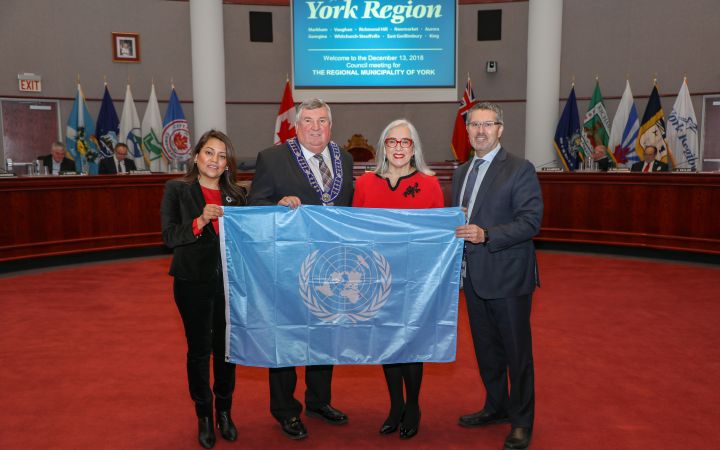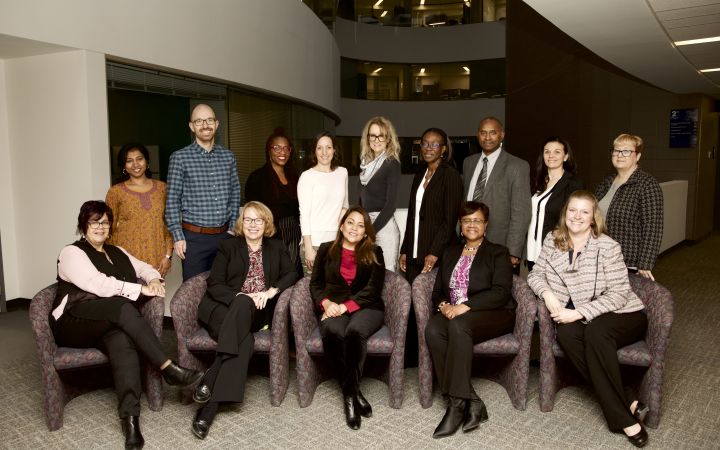Partner: Regional Municipality of York, Canada
Focal Point: Lisa Gonsalves
Title: Director, Strategies and Partnerships Branch, Regional Municipality of York, Canada (on Social Inclusion)
More than ever, immigration and ethnic diversity are at the top of the global political agenda and have been subjects of heated debates. Nativism is driving populism and some people are reluctant to welcome foreigners, thinking that immigration will negatively change their communities, their countries and the economy at large. Studies show that when migrants move from one country to another, they carry a new range of skills and perspectives which nurture innovation and stimulate economic growth. However, newcomers face challenges integrating into their new surroundings. The integration process is often challenging and effective policies are necessary to make sure newcomers feel welcome in their new communities and to accelerate social inclusion. The Regional Municipality of York (York Region) in Ontario is setting an example for other municipal governments to follow.
York Region has a population of 1.2 million people. In 2016, 47% of residents were born outside of Canada, and this figure is expected to grow over the next 10 years. While the majority of the immigrant population arrived in Canada prior to 2001, York Region continues to attract new immigrants at a steady pace. “York Region is a welcoming and inclusive community that openly receives newcomers and promotes social equality”, explains Lisa Gonsalves, Director, Strategies and Partnerships Branch, Community and Health Services at York Region. For example, the 2017–2021 York Region Newcomer Strategy was developed to help newcomers integrate economically and socially in their communities. Moreover, 56% of York Region’s newcomers are economic migrants ready to contribute to the Canadian workforce. Many newcomers to York Region are highly educated but have specific needs that would help them better integrate into the workforce or community. York Region actively works with community partners to ensure that support services are relevant, timely and accessible.”
York Region is fortunate to be part of a coordinated service system with settlement service providers and other organizations that are well equipped to deliver services and supports to newcomers. There are five strategically located Welcome Centres in York Region that have specific responsibilities to help newcomers settle and integrate. These centres operate as service hubs, offering assistance to newcomers, such as language training, orientation workshops, family support groups and referrals to other services to help individuals get settled. However, Lisa and her team realize that there is still more to be done and they need to work closely with other service providers not only to address the needs of newcomers but also others in the community.
“We saw a need for a change of attitude so we began to identify local opportunities to strengthen social cohesion and to build capacity in our own communities”.
York Region sees its diversity as a source of strength, vitality and economic opportunity. With a community that is one of the most diverse communities in Canada, York Region began by asking people what inclusion and diversity meant to them. “We had discussions and engagement sessions with the community to get their input.” Consultations involved over 1,800 individuals and organizations and were carried out together with 20 organizations across York Region. “We have been working together with York Regional Police, local municipalities, our school boards, the hospitals, conservation authorities and agencies to prepare ourselves, our staff and our programmes to be more responsive to everyone, including newcomers”.
This collaborative action resulted in the creation of the Inclusion Charter for York Region. It began with a focus on newcomers but, after consulting with the community, was expanded to embrace people representing all dimensions of diversity. “We wanted to make our community more welcoming and inclusive not just for newcomers but for everyone. By endorsing the Charter, our organizations share the vision of York Region as a community where diversity is celebrated and where everyone can develop to their full potential, participate freely in society and live with respect, dignity and freedom from discrimination.”
The Charter identifies a common commitment to be more welcoming and inclusive, and is a guideline to what each organization will do bring it to life. “It’s not just about words on paper, but rather a commitment to take action”. And action has indeed been taken. Using data and trend analyses, the organizations are developing and implementing many initiatives to create a more welcoming and inclusive York Region.
One of these successful initiatives is the Places of Worship Tour developed by York Regional Police. “New recruits go on this tour as part of their onboarding and orientation programme and now many public servants also have the opportunity to participate in it. During the tour, we visit several different places of worship, meet the leaders of those faith communities and learn about their beliefs. It’s an opportunity for us to engage with the faith community and understand each other better”.
As one of the most diverse communities in Canada, York Region has lots of other activities that promote inclusion. The organization has created quiet rooms, for instance, which are spaces in the workplace designated for prayer, reflection and meditation for employees and are also a way to show the regional government’s support for inclusion. Another one is the Conference for Internationally Educated Professionals, which gathered 500 attendees in its 3rd edition. “This conference was created to bring together internationally educated professionals and potential employers from various sectors. It featured workshops on how to network and keynote immigrant speakers who shared their own experiences”.
But such accomplishments did not come effortlessly. “It took us 6 years to develop the Inclusion Charter for York Region. At the beginning, some organizations didn’t understand what this Charter meant. They were a little bit uneasy about it, so we started very slowly”. However, Lisa is convinced that this approach has paid off.
“I’m glad we didn’t rush through it, because we were able to educate and inform people that probably wouldn’t think of inclusion and diversity the way we do today”.
According to Lisa, part of this success can be attributed to UNITAR’s support of the Charter. “Yes, we’ve been on this journey for quite some time and we’ve done really good work together with our partners, but when UNITAR came into the picture — and I think that is what the UN does — it brought people together! Everything seems to have gone to another level in terms of people being open to jump on board”.
The synergies that emerged from this special partnership helped to spread the work of the Charter beyond York Region’s geographical reach. UNITAR sees the Inclusion Charter as a leading practice model that other jurisdictions can adapt to create more inclusive communities.
Experts from York Region have been invited to share their Charter experiences at workshops and conferences in different places of the world. Presenting at UNITAR’s Road Safety Africa Conference to bring awareness on road safety has been one of the many opportunities to allow such exchanges. The Inclusion Charter was also presented to dignitaries at the UN Headquarters in New York to honour World Interfaith Harmony Week.
“UNITAR is more than a logo on our Charter. This partnership has been incredibly impactful and is helping us with our mission and to move things forward”.



